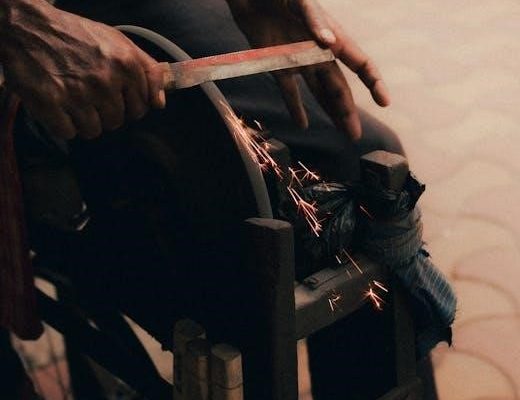Posterior hip precautions are essential guidelines to prevent dislocation after hip replacement surgery. They involve avoiding certain movements, such as bending past 90 degrees or crossing legs. Using assistive devices like walkers or reachers can aid compliance. These precautions help protect the new hip joint during the healing process, ensuring a safe and effective recovery. Adhering to these guidelines is crucial for avoiding complications and promoting long-term success of the surgery.
1.1 What Are Posterior Hip Precautions?
Posterior hip precautions are specific guidelines provided to patients after hip replacement surgery to prevent dislocation of the new joint. These precautions involve avoiding certain movements, such as bending the hip beyond 90 degrees, crossing the affected leg, or turning the foot outward. Patients are also advised to use assistive devices like walkers or reachers to maintain safety. These precautions are tailored to the individual’s recovery needs and are crucial during the initial healing phase to ensure proper alignment and stability of the hip joint.
1.2 Importance of Following Posterior Hip Precautions
Following posterior hip precautions is crucial to prevent dislocation of the new hip joint and ensure proper healing. These guidelines help patients avoid movements that could disrupt the surgical site, reducing the risk of complications. By adhering to precautions, patients minimize the likelihood of additional surgeries and promote a stable, long-term recovery. These measures are essential for safeguarding the hip joint during its most vulnerable phase, ensuring optimal outcomes and faster return to normal activities.
1.3 Overview of the Posterior Hip Replacement Surgery
Posterior hip replacement surgery involves replacing the damaged hip joint with an artificial prosthesis through a posterior approach, accessing the hip joint from the back. This method often allows for shorter recovery times and less muscle damage compared to other approaches. The procedure involves removing the diseased hip joint and securely implanting the prosthetic components. Proper post-operative care, including adherence to hip precautions, is vital to ensure the success of the surgery and minimize the risk of complications such as dislocation.

Why Are Posterior Hip Precautions Necessary?
Posterior hip precautions are necessary to prevent dislocation, protect the new joint, and allow surrounding tissues to heal properly after surgery.
2.1 Healing Process After Posterior Hip Surgery
The healing process after posterior hip surgery requires careful adherence to precautions to ensure proper tissue repair and joint stability. Immediately following surgery, the hip joint and surrounding muscles are vulnerable. Avoiding certain movements, such as bending past 90 degrees or internal rotation, helps prevent dislocation. Using assistive devices like walkers or crutches can reduce strain on the hip. Gradually increasing activity under medical guidance promotes a safe and effective recovery, minimizing the risk of complications.
2.2 Risk of Dislocation Without Proper Precautions
Without proper precautions, the risk of hip dislocation after posterior surgery is significant, especially in the first few months. Movements like bending past 90 degrees, crossing legs, or internal rotation can destabilize the joint. Dislocation can lead to severe pain, medical emergencies, and prolonged recovery. Adhering to guidelines, such as using assistive devices and avoiding risky positions, is critical to safeguard the hip and prevent complications. Ignoring precautions can compromise the surgery’s success and overall recovery.
2.3 Role of Hip Precautions in Promoting Recovery
Hip precautions play a vital role in promoting recovery by protecting the hip joint from dislocation and stress. They allow the soft tissues and muscles to heal properly, reducing the risk of complications. By following these guidelines, patients can enhance mobility and strength gradually. Proper precautions also minimize the likelihood of setbacks, ensuring a smoother and more successful recovery process. Adhering to these measures helps patients regain independence and achieve long-term outcomes from their hip replacement surgery.

Key Posterior Hip Precautions
Key precautions include avoiding hip flexion beyond 90 degrees, preventing internal rotation, and not crossing the affected leg. Proper posture and alignment are also crucial to avoid dislocation.
3.1 Avoiding Hip Flexion Beyond 90 Degrees

Avoiding hip flexion beyond 90 degrees is critical to prevent dislocation after posterior hip surgery. This means refraining from bending at the waist, squatting, or lifting knees past 90 degrees. Patients should use assistive devices like reachers to avoid overreaching. Sitting in chairs with adequate height and using pillows for support can help maintain proper alignment. Strict adherence to this precaution ensures the hip joint remains stable during the healing process, minimizing the risk of complications and promoting successful recovery.
3.2 Preventing Internal Rotation of the Hip
Preventing internal rotation of the hip is vital after posterior hip surgery to avoid dislocation. Patients should avoid turning their knee or foot inward, as this can destabilize the hip joint. Using a pillow between the knees while lying on their back can help maintain proper alignment. Additionally, avoiding positions where the leg naturally rotates inward, such as crossing the legs or toes pointing outward, is essential. Adhering to these guidelines ensures the hip remains stable and promotes a smooth recovery process.
3.3 Avoiding Crossing the Affected Leg
Avoiding crossing the affected leg is critical to prevent dislocation after posterior hip surgery. Crossing the legs or ankles can cause internal rotation and stress on the new hip joint. Patients should keep their legs separated and avoid the “figure 4” position. Using a pillow between the knees while lying on their back can help maintain proper alignment. This precaution ensures the hip remains stable, reducing the risk of complications and promoting a safe recovery process.
3.4 Maintaining Proper Posture and Alignment
Maintaining proper posture and alignment is vital to protect the hip joint after surgery. When sitting, use a supportive chair with a straight back and avoid slouching. Keep your knees at or below hip level to prevent flexion. When standing, stand tall with weight evenly distributed on both legs. Avoid leaning forward or to one side. When lying down, place a pillow between your knees to maintain proper alignment. Proper posture reduces stress on the hip joint and minimizes the risk of dislocation.

Daily Activities and Posterior Hip Precautions
Adapting daily activities after posterior hip surgery is crucial for recovery. Focus on safe sitting, standing, and walking techniques to avoid dislocation. Proper precautions ensure healing and prevent complications.
4.1 Sitting Safely After Posterior Hip Surgery
To sit safely after posterior hip surgery, choose a sturdy chair with a firm seat and back support. Ensure the chair height allows your knees to be at or below hip level. Avoid bending forward to sit; instead, lower yourself slowly using a walker or crutches for support. Keep your knees apart to prevent internal rotation. Place a pillow or cushion on the chair to maintain proper posture. When standing up, use the armrests for assistance and avoid twisting your hips.
4.2 Standing and Walking with Precautions
When standing and walking after posterior hip surgery, use a walker or crutches for stability and balance. Keep your posture straight, avoiding leaning forward. Place your feet shoulder-width apart to maintain proper alignment. Take small, steady steps and avoid rushing. Keep your affected leg slightly bent to prevent full weight-bearing stress. Ensure footwear is non-slip and secure. Always hold onto a sturdy object or use assistive devices when moving, especially on uneven surfaces or stairs.
4.3 Sleeping Positions to Avoid Dislocation
Sleeping on your back is recommended after posterior hip surgery. Place a pillow under your knees to reduce strain on the hip joint. Avoid crossing your legs or ankles, as this can cause internal rotation. If sleeping on your side, use a pillow between your knees to maintain alignment. Never sleep on your stomach, as this can lead to improper hip positioning. Ensure your mattress and pillows provide adequate support to promote healing and prevent dislocation.
4.4 Dressing and Grooming Techniques
Dressing and grooming after posterior hip surgery requires careful attention to avoid dislocation. Use long-handled reachers or grabbers to put on clothing without bending. Sit while dressing to maintain balance and avoid twisting. Avoid crossing your legs or bringing your knee past 90 degrees. Use adaptive clothing, such as elastic waistbands, to simplify the process. When washing, use a long-handled sponge or washcloth to clean hard-to-reach areas. Avoid bending or stretching, and ask for assistance if needed to ensure safety.
Use of Assistive Devices
Assistive devices like walkers, crutches, and long-handled reachers are crucial for safe movement and reducing strain on the hip after surgery, promoting compliance with precautions.
5.1 Benefits of Using a Walker or Crutches
Using a walker or crutches after posterior hip surgery provides stability and balance, reducing the risk of falls and dislocation. These devices minimize strain on the hip joint, allowing proper healing. They also help maintain proper posture and alignment, crucial for recovery. Walkers and crutches enable patients to move safely, promoting independence during the early stages of rehabilitation. By adhering to these tools, patients can avoid complications and ensure a smoother transition to normal mobility.

5.2 Importance of Long-Handled Reachers
Long-handled reachers are vital for patients following posterior hip precautions, enabling them to pick up items without bending or twisting. This reduces the risk of hip dislocation and promotes healing. Reachers allow patients to maintain independence in daily activities, such as dressing and grooming, without compromising their recovery. By minimizing unnecessary movement, these tools play a key role in ensuring compliance with hip precautions and supporting a safe, effective recovery process.
5.3 Using a Leg Lifter for Safe Movement
A leg lifter is a valuable tool for patients adhering to posterior hip precautions, especially when moving their affected leg. It helps avoid bending or twisting at the hip, which can lead to dislocation. By using a leg lifter, patients can safely reposition their leg while sitting or transitioning from bed to chair. This device promotes independence and reduces strain on the hip joint, making it an essential aid during the early stages of recovery and rehabilitation.

Exercises and Physical Therapy
Exercises and physical therapy are crucial for strengthening the hip after surgery. Gentle stretches and guided movements improve mobility and strength.
6.1 Safe Exercises to Strengthen the Hip
Safe exercises, like straight leg raises and seated marching, help strengthen the hip without risking dislocation. Avoid high-impact activities or movements that bend the hip past 90 degrees. Gentle stretching and abdominal strengthening exercises improve stability. Using a walker or crutches during early recovery supports mobility. A physical therapist can tailor exercises to your needs, ensuring proper healing and gradual return to normal activity. These exercises are essential for rebuilding strength and promoting long-term hip stability.
6.2 Role of Physical Therapy in Recovery
Physical therapy plays a vital role in recovery by guiding patients through safe exercises and movements, preventing complications and ensuring proper healing. Therapists recommend using walkers or crutches initially and design personalized exercise plans to strengthen the hip and improve mobility. This support enables a smooth recovery, allowing patients to gradually return to normal activities without risking dislocation.
6.3 Avoiding High-Impact Activities
Avoiding high-impact activities is crucial to protect the new hip joint and prevent dislocation. Activities like running, jumping, or repetitive heavy lifting should be avoided during recovery. These movements can strain the hip, risking complications. Instead, focus on low-impact exercises, such as swimming or cycling, which promote strength without putting excessive stress on the joint. Following these guidelines ensures a safer and more effective recovery process, allowing the hip to heal properly and reducing the risk of long-term damage.

Monitoring and Adjusting Precautions
Regularly monitor your recovery progress and adjust precautions as healing advances. Recognize signs of complications and maintain open communication with your healthcare provider to ensure safe adjustments.
7.1 How to Monitor Progress in Recovery
Monitoring recovery involves tracking pain levels, mobility, and adherence to precautions. Regular follow-ups with your surgeon and physical therapist are crucial to assess healing. Look for improvements in strength and range of motion, and note any unusual symptoms like sudden pain or instability. Keeping a recovery journal can help identify patterns and ensure compliance with guidelines. Open communication with your healthcare team is key to addressing concerns promptly and making necessary adjustments for a successful recovery journey.
7.2 Adjusting Precautions Based on Recovery
As recovery progresses, precautions may be adjusted based on individual healing and clinical assessments. Gradual modifications are made to allow increased mobility while ensuring the hip remains stable. Your healthcare provider will evaluate your progress and tailor precautions to suit your specific needs. Adjustments may include introducing gentle exercises or reducing reliance on assistive devices. Open communication with your therapist is essential to safely transition through recovery phases and minimize risks of complications.
7.3 Signs of Complications to Watch For
Monitor for signs of complications, such as sudden hip pain, instability, or swelling. Difficulty walking or bearing weight may indicate dislocation. Numbness or tingling could signal nerve irritation. Contact your healthcare provider immediately if you experience any unusual symptoms. Early detection of complications is crucial for effective treatment and preventing long-term damage. Stay vigilant to ensure a smooth recovery and address any concerns promptly with your medical team.

Duration of Posterior Hip Precautions
Posterior hip precautions typically last 6-12 weeks post-surgery. The duration may vary based on individual recovery progress and surgeon recommendations. Strict adherence during this period is crucial for optimal healing and minimizing dislocation risks.
8.1 How Long to Follow Posterior Hip Precautions
Posterior hip precautions are generally followed for 6-12 weeks after surgery. The exact duration depends on your surgeon’s recommendations and individual healing progress. Most patients can gradually resume normal activities within 3 months, but full recovery may take up to 6 months. Your surgeon will assess your progress and provide guidance on when it’s safe to discontinue specific precautions. Adhering to this timeline is crucial for ensuring proper healing and minimizing the risk of complications.
8.2 Factors Influencing the Duration
The duration of following posterior hip precautions depends on individual healing rates, surgeon recommendations, and overall health. Patients with stronger bones and tissues may resume normal activities sooner, while those with weaker structures or prior complications may need extended precautions. Compliance with physical therapy and adherence to guidelines also play a significant role. Your surgeon will assess these factors to determine the appropriate timeline for your recovery, ensuring a personalized approach to safeguarding your hip replacement.
8.3 Gradual Return to Normal Activities
A gradual return to normal activities is crucial after hip surgery to ensure full recovery. Patients typically start with light exercises and daily tasks, gradually increasing intensity under medical supervision. The timeline varies, but most regain independence within a few months. It’s important to avoid rushing back to high-impact activities to prevent complications. Patience and adherence to guidelines ensure a smooth transition to normal life, minimizing the risk of dislocation and promoting long-term hip health.

Additional Resources and Support
Downloadable PDF guides, instructional videos, and support groups provide comprehensive resources for patients. These materials offer detailed instructions and community support, aiding in a successful recovery journey.
9.1 Printable Posterior Hip Precautions PDF Guides
Printable posterior hip precautions PDF guides are invaluable resources for patients recovering from hip surgery. These guides outline essential precautions to prevent dislocation and promote healing. They include detailed instructions on safe movements, prohibited positions, and daily activity modifications. Many healthcare providers offer downloadable PDF versions tailored to individual needs. These guides serve as quick references, ensuring patients adhere to their recovery plans. Accessing these materials from trusted medical websites or orthopedic centers guarantees accurate and reliable information for a successful recovery journey.
9.2 Videos and Tutorials for Safe Movements
Videos and tutorials are excellent resources for demonstrating safe movements after posterior hip surgery. These visual guides provide step-by-step instructions on how to perform daily activities, such as sitting, standing, and walking, while adhering to hip precautions. Many orthopedic centers offer short instructional videos that cover essential movements to avoid dislocation. For example, a 2-minute video might review the three main hip precautions to follow for several weeks after surgery. These tutorials often include real-life examples and tips for incorporating precautions into daily routines, making recovery easier and safer.
9.3 Support Groups for Hip Replacement Patients
Support groups for hip replacement patients offer a platform to share experiences and gain emotional support during recovery. These groups, often available online or in-person, provide practical advice and tips for managing posterior hip precautions. They help patients connect with others who have undergone similar surgeries, reducing feelings of isolation. Support groups also offer motivation and encouragement, aiding in both physical and emotional recovery. Participating in these groups can enhance overall well-being and confidence during the healing process.
Adhering to posterior hip precautions is crucial for a successful recovery. Following guidelines ensures proper healing, prevents dislocation, and promotes long-term success of the surgery.
10.1 Summary of Key Points
Posterior hip precautions are vital for preventing dislocation and promoting recovery after surgery. Key points include avoiding hip flexion beyond 90 degrees, preventing internal rotation, and not crossing the affected leg. Using assistive devices like walkers and reachers can aid compliance. Proper posture, safe sleeping positions, and careful dressing techniques are also essential. These guidelines protect the new hip joint during healing, reducing the risk of complications. Adhering to precautions ensures a successful recovery and long-term outcomes for patients following posterior hip replacement.
10.2 Final Tips for Successful Recovery
For a successful recovery, consistently follow posterior hip precautions to minimize complications. Monitor progress, attend physical therapy, and stay in touch with your healthcare team. Keep a positive mindset and maintain a healthy lifestyle. Be aware of signs of dislocation or infection and seek immediate medical attention if they occur. Stay informed and adapt precautions as advised by your surgeon. Compliance and patience are key to ensuring a full and safe recovery after posterior hip replacement surgery.






